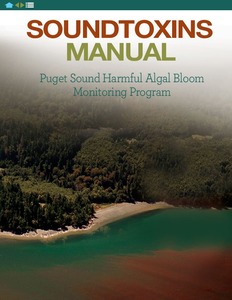| dc.contributor.author | Trainer, Vera | |
| dc.contributor.author | King, Teri | |
| dc.contributor.author | Bill, Brian | |
| dc.contributor.author | Runyan, Jennifer | |
| dc.coverage.spatial | Puget Sound | en_US |
| dc.date.accessioned | 2019-01-04T14:24:59Z | |
| dc.date.available | 2019-01-04T14:24:59Z | |
| dc.date.issued | 2016 | |
| dc.identifier.citation | Trainer, V.; King, T.; Bill, B. and Runyan, J. (2016) SoundToxins manual: Puget Sound Harmful Algal Bloom
Monitoring Program.[Revised December 2015]. Seattle WA, Washington Sea Grant, 36pp. (WSG AS 15-04). DOI: http://dx.doi.org/10.25607/OBP-182 | en_US |
| dc.identifier.uri | http://hdl.handle.net/11329/623 | |
| dc.identifier.uri | http://dx.doi.org/10.25607/OBP-182 | |
| dc.description.abstract | Shellfish are critical to the culture, economy and ecology of Puget Sound. They shape
habitats, provide food for humans and other species, and perform water-filtering
functions important to all organisms that live in or near the Sound. Native American
tribes have long incorporated shellfish into their daily lives through ceremony and art as
well as food. Today Washington State is a national leader in farmed bivalve shellfish, an
industry that provides more than 3,200 family-wage jobs and contributes an estimated
$270 million to the economy (Washington Shellfish Initiative 2011). The majority of
shellfish-farming and recreational harvest opportunities are in rural communities.
Recreation and tourism associated with shellfish harvesting on state-owned beaches
annually accounts for more than $1 million in license sales and an estimated economic
value of $5.4 million (Washington Shellfish Initiative 2011).
Ensuring safe and wholesome shellfish for consumption
relies on water free of terrestrial and legacy pollutants and
toxins from harmful algal blooms (HABs). A phytoplank
-
ton bloom can be harmful in several ways. Some blooms
can produce anoxic (no oxygen) or hypoxic (low-oxygen)
conditions in the water column. This occurs when one or
two species dominate a bloom and block the sunlight from
other organisms in the lower water column. Other plank
-
ton begin to die and decompose. The process of decom
-
position consumes oxygen. Fish die for lack of oxygen and
decomposition continues. Eventually, the massive bloom
dies as well, removing any additional oxygen from the
water column. This entire process can lead to a fish and/or
shellfish die-off, resulting in negative economic impacts.
Harmful algal bloom events lead to closures of shellfish
beds, lost fisheries production, and reductions in tourism
and associated service industries. Fisheries-related busi-
nesses close, insurance and unemployment rates rise, and
public resources are redirected to advisories and monitoring programs.
Human health can also suffer during harmful algal
blooms. About 50 known species of phytoplankton produce
toxins. As toxins move through the food web, they
bioaccumulate in the tissues of large fish and marine
mammals. Humans can contract illnesses from eating
contaminated shellfish and fish, and medical treatment
can be expensive.
Several types of algal toxin present in Puget Sound require
vigilant monitoring to ensure safe shellfish consumption.
Hydrophilic (water-loving) toxins such as the domoic acid
produced by Pseudo-nitzschia spp. and paralytic shellfish
toxins from Alexandrium catenella are currently monitored
and regulated by the Washington State Department of
Health (WDOH). A recent explosion of various lipophilic
(fat-loving) algal toxins, including dinophysistoxins from
Dinophysis spp., have caused various human illnesses and
prompted a complete ban on the importation of Washington
shellfish into the European Union. Of greatest immediate
concern is the presence of algal toxins associated
with diarrhetic shellfish poisoning (DSP), which triggered
a beach closure and a recall of commercial product from
Sequim Bay in August 2011. | en_US |
| dc.language.iso | en | en_US |
| dc.publisher | NOAA/NMFS/NWFSC Marine Biotoxins Program for Washington Sea Grant | en_US |
| dc.relation.ispartofseries | Washington Sea Grant;WSG-AS 15-04 | |
| dc.subject.other | Sampling protocols | en_US |
| dc.subject.other | HAB | |
| dc.subject.other | Harmful algal bloom | |
| dc.subject.other | Phytoplankton | |
| dc.title | SoundToxins manual: Puget Sound Harmful Algal Bloom Monitoring Program. [Revised December 2015]. | en_US |
| dc.type | Report | en_US |
| dc.description.status | Published | en_US |
| dc.format.pages | 36pp. | en_US |
| dc.description.notes | Includes: Horner, R. A brief introduction to marine phytoplankton. | en_US |
| dc.description.refereed | Refereed | en_US |
| dc.publisher.place | Seattle, WA | en_US |
| dc.subject.parameterDiscipline | Parameter Discipline::Biological oceanography::Phytoplankton | en_US |
| dc.subject.dmProcesses | Data Management Practices::Data acquisition | en_US |
| dc.description.currentstatus | Current | en_US |
| dc.description.sdg | 14.2 | en_US |
| dc.description.eov | Phytoplankton biomass and diversity | en_US |
| dc.description.bptype | Best Practice | en_US |
| dc.description.bptype | Manual | en_US |
| obps.contact.contactemail | vera.l.trainer@noaa.gov | |
| obps.resourceurl.publisher | https://wsg.washington.edu/wordpress/wp-content/uploads/Sound-Toxins-Manual-2016.pdf | en_US |
 Repository of community practices in Ocean Research, Applications and Data/Information Management
Repository of community practices in Ocean Research, Applications and Data/Information Management
